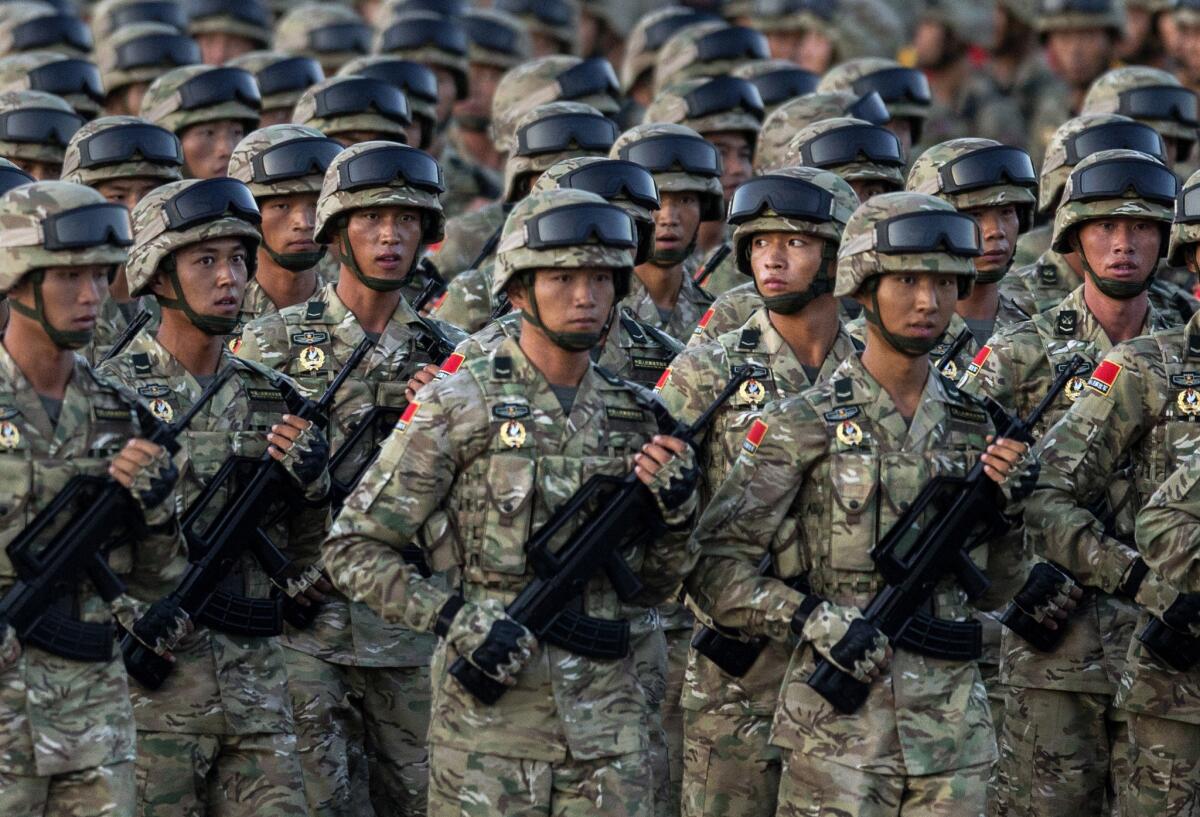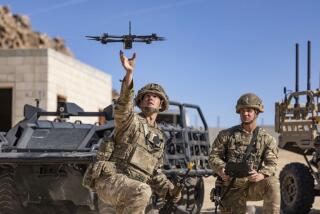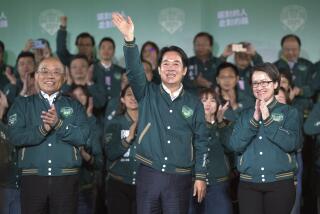China’s military: How strong is the People’s Liberation Army?

Chinese soldiers march past Tiananmen Square before a military parade in Beijing marking the 70th anniversary of the end of World War II.
- Share via
Reporting from Beijing — China’s People’s Liberation Army is the world’s largest military force, with 2.3 million troops serving on the ground, in the air and in the increasingly robust force China is deploying on the high seas.
With Beijing’s increasing military assertiveness, most notably in territorial disputes with other Asian nations in the South China Sea, many are taking a hard look at the PLA and Beijing’s ambitions to modernize it.
China has upped its military budgets by more than 10% a year over the last five years -- at least as reported -- but what’s been the result?
Ahead of China’s big military parade on Thursday, we asked Roger Cliff, a senior fellow at the Atlantic Council and author of the forthcoming book “China’s Military Power: Assessing Current and Future Capabilities,” for his take on the state of the PLA. Here, in condensed form, is what he had to say:
How does the People’s Liberation Army compare to the U.S. military?
When assessing military capability, we do tend to focus on material factors like numbers of tanks or soldiers. But historically this has not been a very good predictor of the outcomes of wars. It’s much more about how militaries are trained and organized and the quality of people they have.
People in the U.S. military use a term called DOTMLPF: Doctrine, organization, training, materiel, leadership, personnel and facilities. I kind of took that general idea and sliced it up on my own way for my book and looked at those dimensions.
The finding was: If you look at measures like hardware, certainly the Chinese military has gotten a lot of attention recently and looks pretty good. To me, the more surprising finding was personnel quality. The Chinese military, the PLA, has been on a major drive to create better-educated soldiers and my finding is that the average PLA soldier, though we have this image of a peasant army, today is as well-educated as his or her American counterpart.
China’s military is not going to surpass the U.S. anytime soon, but they’re certainly closing the gap. That’s relevant to what we’re going to see [during the parade].
Most of the systems that they’re fielding nowadays are comparable to what make up the bulk of the U.S. military. These still kind of represent a minority of the equipment in the Chinese military; a lot of it is still antiquated and based on 1950s Soviet designs, but the new systems they are bringing out now are comparable to what makes up the bulk of the U.S. military — M-1 tanks and F-16 fighter jets and the types of destroyers we have in our Navy.
Most of these systems in the U.S. are not new; they first started coming out in the ’80s and ’90s. Because we’ve been so preoccupied with conflicts in the Middle East over the past decade or so, low insurgency conflicts, we haven’t really made the leap to next-generation systems for the most part.
By 2020, the equipment of the Chinese military will look a lot like the U.S. military in 2000. One way to look at it is that ‘Wow, even in 2020 they’ll still be 20 years behind the U.S. military,’ but there hasn’t been much modernization of the U.S. military and there won’t have been by 2020. So they really won’t be that far behind us in terms of equipment.
What about the organizational structure?
There are some structural problems: They still have a model that is heavily based on conscripts, that is, people brought in for two-year terms, and then the vast majority are released. So you have a huge percentage that are in their first or second year of service at any given time. But that’s sort of compensated for by the fact that senior non-commissioned officers are at least as educated or better educated than their Western counterparts.
When you look at personnel, they’ve made the transformation from a mass peasant army to one that has more experience and … they’re also improving in other areas like the quality of their training. But there are significant problems, particularly in the area of logistics.
What about their operational doctrine?
One can kind of crudely arrange different kinds of operational doctrines along a spectrum, starting on one end with those based on direct engagement; that is, taking your best forces and trying to directly attack the enemy and break his back through a direct clash of arms. That was in WWII pretty much how the U.S. and Britain won. They had doctrines that were … not very flexible and very much based on just taking advantage of materiel superiority.
Certainly in the early part of the war, the German military had a different doctrine, one of indirection and maneuver. The idea is not to engage in a direct clash of arms but look for weak points in your enemy’s forces, attack those, try to paralyze him by disrupting his organization and so on.
Interestingly, the Chinese around 1999 implemented a new doctrine that also emphasized maneuverability and flexibility, attacking an enemy’s weak point and avoiding a direct clash of arms. That makes sense in the context of the 1990s when they were materially and technologically quite a bit inferior to potential adversaries like the U.S., but also Japan or even Taiwan at the time.
But the problem I discovered is they don’t have the right kind of organizational structure or culture to be able to implement a doctrine like that. If you have a doctrine of maneuver and indirection, you need an organization that is decentralized, not standardized, so that it allows low-level decision makers to make a decision that is the best one based on the context they’re in rather than one based on standard operating procedure. You also need horizontal linkages so that people on the front lines can talk directly to each other even if they’re not in the same chain of command, rather than having to go up the line.
In fact, China’s military’s organization is just the opposite of that. It’s highly centralized, all decisions are kicked upstairs. No one wants to take the initiative, no one’s responsible, everything’s always referred up the chain of command and everything’s highly standardized, you’re supposed to follow standard procedures and not deviate from them. There are low levels of horizontal integration.
What about the culture of the Chinese military?
If you look at culture of the organization, I find a similar problem. If you want a doctrine of maneuverability and innovation, you want an organization that values things like initiative and innovation, creativity and risk-taking. Instead we have an organization that values discipline and loyalty. Not the kind of organizational culture you would want to implement for a doctrine that calls for commanders in the field to make snap decisions to take advantage of fleeting opportunities only they can see and need to be exploited immediately, otherwise the opportunity will be missed.
I see this as the fundamental weakness of the Chinese military. They are acquiring all the material and obvious sorts of non-material factors that go into an effective military but they don’t have the organization or the culture they would need to actually become one.
But it sounds like their weaponry is coming more into alignment with their — stated or not — highly structured organizational culture. Aren’t those getting closer into alignment as they acquire these new toys?
That’s a good point. This idea that they need to have a doctrine of maneuver and indirection because of their material inferiority is becoming less and less persuasive. They are becoming less and less inferior, materially.
My profession involves worrying about what China is going to do with their growing materiel capabilities. Despite the fact that they don’t have an agile organizational structure or culture. There are certainly many ways they can make things difficult for the U.S. They are, however, not yet in a position of materiel superiority relative to the U.S. Until you reach that point, I think it does translate into disadvantages. So not to dismiss the significance of the materiel capabilities that China is acquiring in terms of weaponry, but they do remain technologically behind the U.S. Both in terms of the quality and number of their systems — the Chinese have more soldiers but don’t outnumber the U.S. in terms of fighter aircraft, warships and so on. And U.S. technological capabilities are superior to China’s.
What advantages does China have?
One advantage China does have is that the most plausible conflict involving China would occur in its backyard. Whereas the U.S. when it gets involved in a war, it’s usually on the other side of the world and it has to project its power to the far side of the globe. That gives China the home field advantage.
Certainly the Chinese military is becoming a lot more powerful with respect to other militaries in the region such as Japan or Taiwan or anybody else in the region. But there are some fundamental weaknesses in the organizational culture than make them less impressive than they look to be when viewing just the materiel capabilities. Certainly they are not in a position to rival the U.S. as a global superpower.
There’s been a lot of reports about corruption in the Chinese military. Senior military officials have been removed on graft accusations and there’s been talk of trading bribes for promotions. Does this affect their effectiveness?
Corruption is a behavior. So it’s significant for two reasons. One, there’s a definite cost associated with corruption — money that is changing hands was intended for other purposes. Instead of being used to buy equipment or whatever, instead it’s being used to buy promotions or that sort of thing. So there’s an economic cost associated with corruption.
There’s also a cost in terms of organizational efficiency, because in the case of bribing for promotions, it means the person who’s getting promoted is not the most capable but the one that provides the biggest bribe. So the organization isn’t promoting the most capable people. It’s a huge and significant issue for the PLA. But the problem is the PLA is focused on the behavior, not the values underlying the behavior.
Why does corruption occur in the PLA? Because apparently there’s money to be made by either getting promoted or helping other people get promoted. But there’s also a set of values associated with corruption.
Corruption tends to be more prevalent in organizations with low levels of trust. Corruption tends to be more prevalent in organizations that value loyalty. The problem I see is the Chinese leadership trying to stamp out the behavior without changing the underlying values that are causing the behavior as well as the economic incentives.
Why is China doing this parade and why now?
There’s been a lot of speculation about this. China has had these parades before. Most recently in 2009. It was quite an impressive display of marching abilities, colorful uniforms and so on. But in the past they’ve done it on the anniversary of the founding of the People’s Republic of China and that’s not the case this time.
Now I am in the realm of speculation, but obviously the top leadership decided to have this military parade, presumably this means President Xi Jinping. He wanted a big military parade partly to send a message to other countries in the region but the more important audience is the domestic audience for things like this.
One can imagine a couple of reasons why Xi Jinping wants to send such a message — first, to emphasize the importance of the Chinese military and thereby the security threats to China that exist. Second, to emphasize that he’s creating a powerful China. That’s certainly been an integral aspect of his signature campaign to promote the ‘China Dream.’ Part of that has been a strong China or a strong military. So I think he wants to send the message that he is doing that.
An interesting thing to look for will be — during the one in 2009, I was sort of struck by how colorful it was, and sort of friendly. Even though it was a military parade, it wasn’t a very ominous or a threatening one in my opinion. It looked very friendly. So it will be interesting to see if the same tone comes through this time. Or are they trying to look more serious or menacing? That will be an interesting thing to watch for. Is this all about pageantry and everyone marching in sync?
Are they sending the message that this is a nice military that’s here to help? Or are they sending the message that this is a big, gnarly, mean, tough military that will bop you over the head if you try to get in their way? I think that will be an interesting thing to see, and presumably which way it falls will be part of the message.
Follow @JulieMakLAT for news from China
More to Read
Sign up for Essential California
The most important California stories and recommendations in your inbox every morning.
You may occasionally receive promotional content from the Los Angeles Times.











